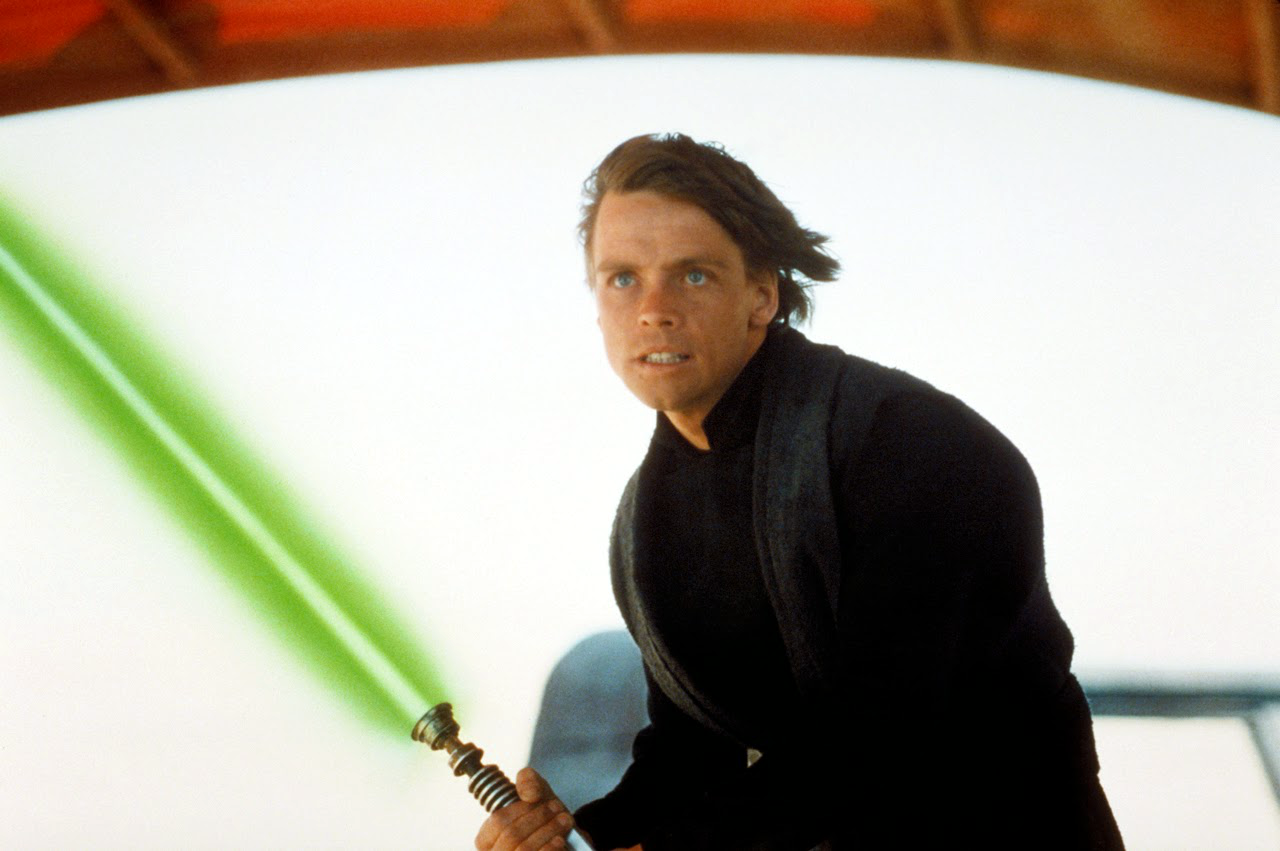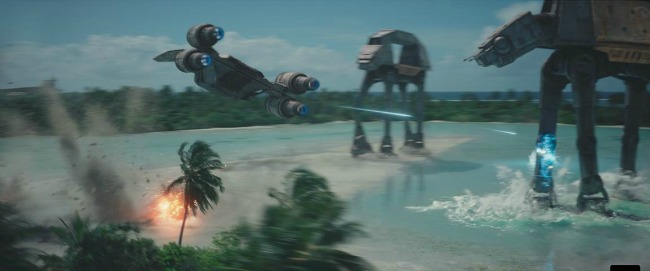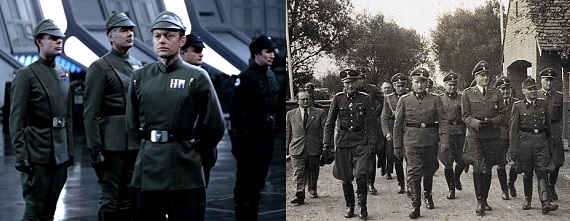Whether George Lucas intentionally did this or not, there is a strong parallel between World War II and the Star Wars, that spans many different aspects of the franchise. While I am certainly not the first or last person to notice this resemblance (it is the discussion of a plethora of online chatrooms), there has yet to be much official proof that the parallels are purposeful, I thought the possible inspiration for the movie both strengthens our understanding of WWII and even puts the classic movies in a different light for examination.
The Empire
The strongest and most obvious parallel that exists between WWII and Star Wars surrounds the Empire. With great power and a strict hierarchy, the Empire takes clear influence from Nazi Germany.
Stormtroopers
Nazi "Sturmabteilung" were the storm troops from the end of WWI who were small units of fast-moving troops. In the 1920s, when the Nazi party began, they made their own storm troops modeled after those from the first World War to protect themselves, resembling how the stormtroopers were one of the first parts of the Empire and the core protection of its power.

Darth Vader
One of the key leaders of the Empire, Darth Vader could be easily compared to the Nazi leader: Adolf Hitler. With the German name Vader, a clear link between these men is established. Both men are cunning, feared, and highly respected by the soldiers who work beneath them, and can be very cruel to those they encounter. With regards to physical appearance, one could also argue that Darth Vader's breathing mask somewhat resembles Hitler's infamous mustache. These great leaders were both incredibly dedicated to their cause, fighting hard both through their swell of gaining additional lands and men as well as during the ultimate downfalls of their empires. Additionally, both men die as the defeat of their empires becomes clear, although admittedly Hitler died a villain by suicide and Vader died in a final heroic act that somewhat makes up for some of his actions.
The Death Star
A weapon of mass destruction that allows the Empire to threaten people into submission and kill innocent civilians to make a point, the Death Star echoes many different parts of WWII. Overall, it is a representation of the new technology that elevated WWII to a new type of war. With more advanced planes, ships, tanks, and bombs, WWII was far more technologically advanced than WWI. Armies and countries possessed more power, but their losses were also greater and this new tech caused greater destruction. The Death Star might also represent the way Hitler threatened small countries that bordered Germany into submission. With a laser strong enough to explode an entire planet, no one wanted to cross the Empire after an example was made of Alderaan, a planet of kindly pacifists. And this brings me to the third parallel between WWII and Star Wars that the Death Star makes: the ethics of killing civilians for war. The people of Alderaan can be used as a parallel for civilians of any country involved in the war; they don't see action, they are uninvolved in what decisions are made by the leaders, and some of them might not even want their country to be in the war at all. Yet, with the new technologies in WWII, somewhere between 50 and 80 million of these innocent civilians perished. The clearest event that the explosion of Alderaan mirrors is the bombings of Hiroshima and Nagasaki. While both the Empire and the United States could have won control over their enemies without a cruel display like this, each wanted to exhibit their groundbreaking weaponry and strike fear in the hearts of each and every observer to gain international respect. Both events involved a mass murder of enemy civilians who didn't need to die, and neither the US nor the Empire displayed any indication that they felt bad for what they had done.


Luke Skywalker
Luke's childhood on a farm in a remote desert to me seems like a clear parallel to a teenager growing up on a farm on the sparsely populated Great Plains; to me, this and other things make it clear that Luke Skywalker is a representation of the average American soldier. With plans for a future ahead of him (Luke hopes to go on to an academy) interrupted by the more imminent need for war (when Obi-Wan convinces him to join the Rebellion), Luke further represents the average soldier, whose life was interrupted by the draft and who was sent off to an unfamiliar land (the Death Star) with unfamiliar technology (lightsabers) which required training to understand and master (learning to use the force). Luke comes late into the Rebellion which he had never heard of before, which seems to parallel how the Americans didn't enter the war until far after it began and how most Americans were uninterested in the business happening in Europe. Additionally, Luke doesn't join the Rebellion until he is directly affected by the waging war when stormtroopers kill his aunt and uncle, like how America didn't enter the war until they were attacked at Pearl Harbor. Once part of the Rebellion, Luke goes on to be a pilot for the rebellion, having to make the famous shot into the Death Star that caused it to explode, with the same precision that pilots in WWII needed to have in gunning down enemy planes or boats or bombing areas so as not to kill too many civilians. He ends up making sacrifices for the war (losing his regular life as well as his hand), but in the end comes out victorious through it all.


Order (90)66
While I am not quite sure of what the parallel could be between these two executive orders, if one exists at all, I thought this was definitely a notable similarity that needs mentioning. It doesn't seem like Star Wars is trying to make a statement about Order 9066 with Order 66, the numbers seem more similar than just coincidence. In any case, FDR and Palpatine each make a rash decision to authorize an order that ends up being detrimental to a group of people: the Japanese and the Jedi.


Two Trilogies
Overall, one of the main parts of the parallel is the title Star WarS, plural. While in the original trilogy, there is only one war being waged, clearly Star Wars is referencing multiple battles that have happened throughout history. While some were confused by the necessity of the prequel trilogy, the general claim is that the original trilogy cannot be completely understood without the reference of the prequel trilogy, or the first war that set up the second. This is just like how without a knowledge and understanding of WWI, WWII doesn't mean the same thing or have the same effect. With the echoes he sets up between the two trilogies of a young hero, a mentor, a powerful villain, etc., it seems like George Lucas is trying to say something along the lines of "history has a habit of repeating itself". In comparing the two trilogies to the two World Wars, it seems that the prequels do resemble WWI, with a lot of politics, diplomacy, and war councils: it was a more civilized war. Likewise, the original trilogy throws the "rules" of war out the window and each side does whatever it takes to win the war, just like how both the Axis powers and the Allies disregarded the laws of war at one time or another in order to help themselves gain the upper hand.
The Force Awakens
While in all honesty, the third trilogy was probably just a chance to make even more money on a beloved franchise, it is possible that with the third trilogy, Star Wars is making a statement that with the repetition of history, a third World War is entirely possible and maybe even on the brink of happening. With each successive trilogy, the technology as well as the intensity increase. While the original trilogies had clear hints to Nazis and Germany, the third trilogy has a scene that is blatantly and undeniably based on Nazi Germany. What it seems this trilogy might end up saying is that the intensity and brutality of war will just continue growing and repeating if it continues to go unchecked.

Rogue One
While this doesn't really fit with anything else I have said up to this point, one thing I wanted to mention from Rogue One was the scene where the rebels are struggling to make ground on the beach. I could not watch this scene without thinking of D-Day. It seems like a clear parallel to the soldiers fighting along the beach while being fired down at, complete with rebel soldiers being easily knocked off one by one and having to be left behind for the good of the mission.


Overall, whether intentional or not, many possible parallels exist between the vast Star Wars universe and the World Wars that have affected our planet in the past century, and it is certainly interesting to reflect on what the famous franchise might be saying when viewed through the lens of World War II.
http://www.starwars.com/news/from-world-war-to-star-wars-stormtroopers
http://www.history.com/news/the-real-history-that-inspired-star-wars
My knowledge of Star Wars and WWI and WWII

Kenneth, this was a very insightful and interesting perspective of WWII; I would have never been able to draw parallels between the war and the Star Wars franchise, but you were able to make it clear and concise. It's interesting to think that George Lucas did base the storyline of Star Wars on the two World Wars, representing certain aspects of the war in a fictional light perhaps to reach a larger audience with their message. I particularly thought the connections between the three trilogies and the two (possibly three?) was interesting, especially your point about how the third may be an implication of events to come in the future. Great job connecting what we've learned in class to your outside knowledge, and excellent work in including photos of certain, specific scenes as evidence to back up your claims.
ReplyDelete